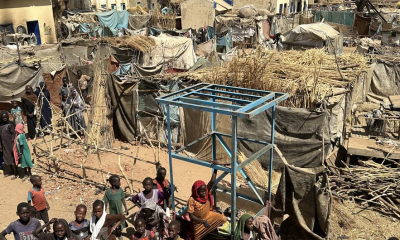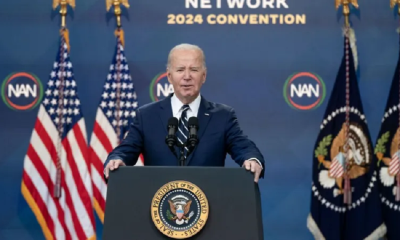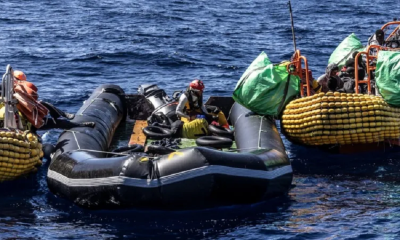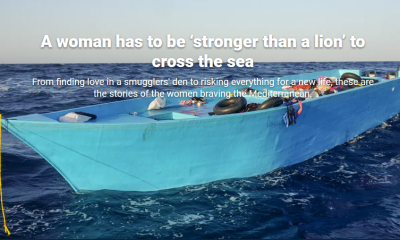Features
Trade with the Middle East – Libya, Syria, Egypt and Iraq
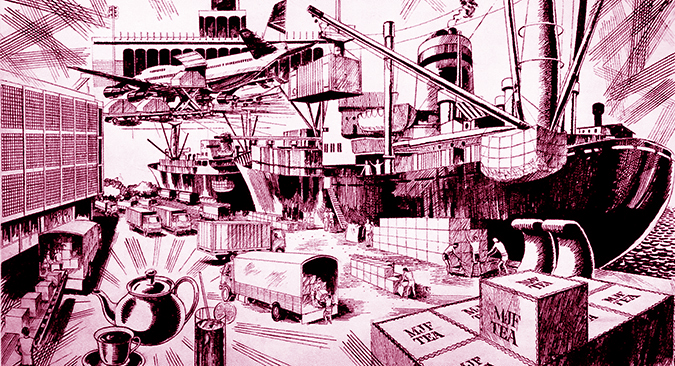
(Excerpted from the Merrill, J, Fernando autobiography)
Libya: In my bulk trading days, I did considerable business with the Middle East. AF Jones and another company dominated the supply volumes to Libya. In retrospect, I deeply regret the environmental damage caused by this trade, as many tea shipments were in five and 10 kg packs, in sapu and albizzia boxes. These were shipped out regularly in container loads. Our distributor in Libya was a wealthy Maltese family, M. Albernozo and his two sons, John and Marcel.
Libya is a beautiful country and was administered as a colony of Italy from 1912 till well in to World War II. After the defeat of the Italian and German forces in Africa, Libya was under Allied occupation from around 1943 to 1951. The Italian influence is very evident in their food, drink, and clothing. Food, in fact, was also as cheap as drink. A good bottle of wine cost no more than a shilling.
Until the overthrow of King Idris, who ruled the country from 1951 to 1963, when he was ousted in a coup by Colonel Muammar Gaddafi, it was a comfortable country to trade in. I visited Libya regularly from 1958 till about 1985. In the early days I used to stay at the Grand Hotel, Tripoli, an old but well-maintained hotel overlooking the harbour. Both the service and food were very good when it was being managed by an Italian group.
Gaddafi introduced an iron-fisted rule and his style of governance soon impacted on my business in the country as well. Procedures for foreigners at the airport became difficult and humiliating, with arrogant young immigration officials being equally discourteous and unhelpful. Once, I was rudely told to fill my disembarkation card in Arabic! Customs inspectors treated all incoming visitors as if they were potential smugglers, checking travel bags by simply throwing the contents out.
The best hotel in Tripoli at that time was the Al Waddan, referred to as the “Waldorf Astoria of Tripoli,” built in 1935 and designed in collaboration by two famous Italian architects. Accommodation, service, and food were excellent, until Gaddafi issued an edict suddenly that all foreigners employed in the country should leave within 24 hours. My distributor, Albernozo’s Finance Director, a Greek, was told that whilst he could stay on, his Italian wife would have to leave the country immediately. The quality of facilities and services declined but business continued to be good, though the import trade was also nationalized.
Albernozo returned to Malta soon afterwards and we continued our business with Nasco, a large Libyan tea importing company. I established a good relationship with its Chairman, Mohammed Zigallai, who gave me some decent orders. Conditions within the country, however, became both restrictive and oppressive under the Gaddafi regime. At the request of my friends in the country, on my visits to Libya I used to carry with me many items which had become unavailable in the country. However, more often than not, those had to be left behind at the Customs.
The discovery of oil in Libya enriched it and the country prospered during Gaddafi’s rule, despite its authoritarianism. However, his military interventions in other countries in the region and internal opposition to his rule created instability within. The civil strife, compounded by NATO-led military action led against Gaddafi, culminated in his death in 2011. Since then, that once-peaceful country has been in a constant state of turmoil.
Syria
My experience with Syria too mirrors those of Libya. I found it to be a very sophisticated society, a composite of an ancient classical culture reaching back many centuries and influenced subsequently by French colonization. Its tea trade had been in private hands for many years and I used to visit the country at least twice a year. Syrians, by nature, were very friendly and I formed warm relationships with my business contacts, who frequently invited me to their homes for meals.
Once the importation was taken over by the State organization, TAFCO, the nature of my interactions in the trade changed dramatically. The new barons of the import/export trade were blatantly dishonest and attempted to entice me into various fraudulent schemes, the main purpose being personal enrichment through deliberate downgrading of the quality of deliveries, against agreed shipment standards. The shipment broker came to meet me several times seeking commissions as well. I refused to compromise on quality and, as a result, lost the business.
Egypt
Egypt was another lucrative market for Ceylon Tea until its nationalization of the import trade. My first agent, who is my friend to this day, was Ibrahim Soudan and his family. My business with Egypt went very well, during a period when Egypt was buying about 40 million kg of Ceylon Tea annually. However, the Egyptian Government signed a trade pact with Kenya and the Egyptian off take of Ceylon Tea diminished rapidly as a result.
Today, the Egyptian market is dominated by cheaper East African teas and the Ceylon Tea presence is not significant. However, with the development of the tea bag market, Dilmah is regaining a foothold in Egypt. Regrettably, with the commencement of my food service and restaurant supply business, by mutual agreement, we severed our business connection with the Soudan family. They were importing their own brand in Ceylon packs, supplied by my friend Gamini Fernando’s company, Ceylon Tea Marketing.
Our agent in the restaurant tea supply business is my very good friend, Hassan Al Shahin, one of the biggest merchants in Egypt. It is a great privilege to deal with people like Hassan and Ibrahim, warm and family-oriented businessmen, with whom I have established trade connections spanning generations. Before long, between those family companies and Dilmah, there will be respective third generations trading with each other.
That is the charming connectivity of the world of tea, especially when the business is controlled not by multinationals but by families with a philosophy of delivering genuine quality to the customer. That was also the attractive and genuine face of much of the international trade many decades ago, before being rolled over by the multinational juggernaut.
Iraq
In Iraq, a country which is still an important destination for Ceylon Tea, my distributor was Dhanoon Ahmed Khootachi. He provided me with very good business, taking care of me personally on my visits to the country. I used to stay in the Baghdad Hotel, where food and service were both excellent. However, hotel accommodation used to be both limited and expensive and, in view of the stringent exchange controls in Ceylon, one had to be frugal as well.
It was not uncommon for delegates from Ceylon to overseas trade fairs to share hotel rooms, especially when the more affluent delegates from other countries, or from the richer companies from Ceylon itself, commandeered available accommodation. I recall one occasion in Iraq when I shared a room, I think with my friend Kumar Paul. I slept the night on a sheet I spread on the floor.
Once the trade was nationalized in Iraq, the importation of tea passed from private hands to the State-controlled Iraqi Government Tea Purchasing Board. Its representative in Sri Lanka would purchase the country’s requirements, generally around 30 million kg per year, through appointed agents in the country. The first such representative was Farouk Murad, who was accompanied to the country by his wife and his two children. I was a regular supplier for many years.
The decline of Iraq in the last decade is not dissimilar to the fate of Libya; engineered largely by the US and UK, through the transparently-false ploy of a search for weapons of mass destruction, when the real motive was the destabilization of the Saddam Hussein regime and the seizure of control of oil production.
In essence, the Middle East was a common market for tea, with a general similarity of consumer preferences across most countries. When Egypt, Iraq, Iran, Syria, and Libya were free markets, with several importers purchasing tea in Colombo, there was a healthy market competition. Once the economies of those states came under central state control, with one corporation representing 20-30 buyers, countries like Egypt and Iraq established their own buying offices in Colombo.
Purchasing arrangements impacted on prices. When a delegation came out to make large-scale purchases, exporters competed with each other to sell at unrealistic prices, which spelled disaster to the Low-Grown producers. The system of large-volume forward contracts, not an uncommon feature then, contributed to price depressions which prevailed for months.
The Syrian tender procedure also paved the way for various irregularities. Another factor is that when centrally-controlled economies are represented by a single buyer to the country, they also have the power to determine the sources of supply, invariably gravitating to the cheapest buying centre, to the obvious detriment of Ceylon Tea, which has always been the highest priced.
Features
The heart-friendly health minister

by Dr Gotabhya Ranasinghe
Senior Consultant Cardiologist
National Hospital Sri Lanka
When we sought a meeting with Hon Dr. Ramesh Pathirana, Minister of Health, he graciously cleared his busy schedule to accommodate us. Renowned for his attentive listening and deep understanding, Minister Pathirana is dedicated to advancing the health sector. His openness and transparency exemplify the qualities of an exemplary politician and minister.
Dr. Palitha Mahipala, the current Health Secretary, demonstrates both commendable enthusiasm and unwavering support. This combination of attributes makes him a highly compatible colleague for the esteemed Minister of Health.
Our discussion centered on a project that has been in the works for the past 30 years, one that no other minister had managed to advance.
Minister Pathirana, however, recognized the project’s significance and its potential to revolutionize care for heart patients.
The project involves the construction of a state-of-the-art facility at the premises of the National Hospital Colombo. The project’s location within the premises of the National Hospital underscores its importance and relevance to the healthcare infrastructure of the nation.
This facility will include a cardiology building and a tertiary care center, equipped with the latest technology to handle and treat all types of heart-related conditions and surgeries.
Securing funding was a major milestone for this initiative. Minister Pathirana successfully obtained approval for a $40 billion loan from the Asian Development Bank. With the funding in place, the foundation stone is scheduled to be laid in September this year, and construction will begin in January 2025.
This project guarantees a consistent and uninterrupted supply of stents and related medications for heart patients. As a result, patients will have timely access to essential medical supplies during their treatment and recovery. By securing these critical resources, the project aims to enhance patient outcomes, minimize treatment delays, and maintain the highest standards of cardiac care.
Upon its fruition, this monumental building will serve as a beacon of hope and healing, symbolizing the unwavering dedication to improving patient outcomes and fostering a healthier society.We anticipate a future marked by significant progress and positive outcomes in Sri Lanka’s cardiovascular treatment landscape within the foreseeable timeframe.
Features
A LOVING TRIBUTE TO JESUIT FR. ALOYSIUS PIERIS ON HIS 90th BIRTHDAY

by Fr. Emmanuel Fernando, OMI
Jesuit Fr. Aloysius Pieris (affectionately called Fr. Aloy) celebrated his 90th birthday on April 9, 2024 and I, as the editor of our Oblate Journal, THE MISSIONARY OBLATE had gone to press by that time. Immediately I decided to publish an article, appreciating the untiring selfless services he continues to offer for inter-Faith dialogue, the renewal of the Catholic Church, his concern for the poor and the suffering Sri Lankan masses and to me, the present writer.
It was in 1988, when I was appointed Director of the Oblate Scholastics at Ampitiya by the then Oblate Provincial Fr. Anselm Silva, that I came to know Fr. Aloy more closely. Knowing well his expertise in matters spiritual, theological, Indological and pastoral, and with the collaborative spirit of my companion-formators, our Oblate Scholastics were sent to Tulana, the Research and Encounter Centre, Kelaniya, of which he is the Founder-Director, for ‘exposure-programmes’ on matters spiritual, biblical, theological and pastoral. Some of these dimensions according to my view and that of my companion-formators, were not available at the National Seminary, Ampitiya.
Ever since that time, our Oblate formators/ accompaniers at the Oblate Scholasticate, Ampitiya , have continued to send our Oblate Scholastics to Tulana Centre for deepening their insights and convictions regarding matters needed to serve the people in today’s context. Fr. Aloy also had tried very enthusiastically with the Oblate team headed by Frs. Oswald Firth and Clement Waidyasekara to begin a Theologate, directed by the Religious Congregations in Sri Lanka, for the contextual formation/ accompaniment of their members. It should very well be a desired goal of the Leaders / Provincials of the Religious Congregations.
Besides being a formator/accompanier at the Oblate Scholasticate, I was entrusted also with the task of editing and publishing our Oblate journal, ‘The Missionary Oblate’. To maintain the quality of the journal I continue to depend on Fr. Aloy for his thought-provoking and stimulating articles on Biblical Spirituality, Biblical Theology and Ecclesiology. I am very grateful to him for his generous assistance. Of late, his writings on renewal of the Church, initiated by Pope St. John XX111 and continued by Pope Francis through the Synodal path, published in our Oblate journal, enable our readers to focus their attention also on the needed renewal in the Catholic Church in Sri Lanka. Fr. Aloy appreciated very much the Synodal path adopted by the Jesuit Pope Francis for the renewal of the Church, rooted very much on prayerful discernment. In my Religious and presbyteral life, Fr.Aloy continues to be my spiritual animator / guide and ongoing formator / acccompanier.
Fr. Aloysius Pieris, BA Hons (Lond), LPh (SHC, India), STL (PFT, Naples), PhD (SLU/VC), ThD (Tilburg), D.Ltt (KU), has been one of the eminent Asian theologians well recognized internationally and one who has lectured and held visiting chairs in many universities both in the West and in the East. Many members of Religious Congregations from Asian countries have benefited from his lectures and guidance in the East Asian Pastoral Institute (EAPI) in Manila, Philippines. He had been a Theologian consulted by the Federation of Asian Bishops’ Conferences for many years. During his professorship at the Gregorian University in Rome, he was called to be a member of a special group of advisers on other religions consulted by Pope Paul VI.
Fr. Aloy is the author of more than 30 books and well over 500 Research Papers. Some of his books and articles have been translated and published in several countries. Among those books, one can find the following: 1) The Genesis of an Asian Theology of Liberation (An Autobiographical Excursus on the Art of Theologising in Asia, 2) An Asian Theology of Liberation, 3) Providential Timeliness of Vatican 11 (a long-overdue halt to a scandalous millennium, 4) Give Vatican 11 a chance, 5) Leadership in the Church, 6) Relishing our faith in working for justice (Themes for study and discussion), 7) A Message meant mainly, not exclusively for Jesuits (Background information necessary for helping Francis renew the Church), 8) Lent in Lanka (Reflections and Resolutions, 9) Love meets wisdom (A Christian Experience of Buddhism, 10) Fire and Water 11) God’s Reign for God’s poor, 12) Our Unhiddden Agenda (How we Jesuits work, pray and form our men). He is also the Editor of two journals, Vagdevi, Journal of Religious Reflection and Dialogue, New Series.
Fr. Aloy has a BA in Pali and Sanskrit from the University of London and a Ph.D in Buddhist Philosophy from the University of Sri Lankan, Vidyodaya Campus. On Nov. 23, 2019, he was awarded the prestigious honorary Doctorate of Literature (D.Litt) by the Chancellor of the University of Kelaniya, the Most Venerable Welamitiyawe Dharmakirthi Sri Kusala Dhamma Thera.
Fr. Aloy continues to be a promoter of Gospel values and virtues. Justice as a constitutive dimension of love and social concern for the downtrodden masses are very much noted in his life and work. He had very much appreciated the commitment of the late Fr. Joseph (Joe) Fernando, the National Director of the Social and Economic Centre (SEDEC) for the poor.
In Sri Lanka, a few religious Congregations – the Good Shepherd Sisters, the Christian Brothers, the Marist Brothers and the Oblates – have invited him to animate their members especially during their Provincial Congresses, Chapters and International Conferences. The mainline Christian Churches also have sought his advice and followed his seminars. I, for one, regret very much, that the Sri Lankan authorities of the Catholic Church –today’s Hierarchy—- have not sought Fr.
Aloy’s expertise for the renewal of the Catholic Church in Sri Lanka and thus have not benefited from the immense store of wisdom and insight that he can offer to our local Church while the Sri Lankan bishops who governed the Catholic church in the immediate aftermath of the Second Vatican Council (Edmund Fernando OMI, Anthony de Saram, Leo Nanayakkara OSB, Frank Marcus Fernando, Paul Perera,) visited him and consulted him on many matters. Among the Tamil Bishops, Bishop Rayappu Joseph was keeping close contact with him and Bishop J. Deogupillai hosted him and his team visiting him after the horrible Black July massacre of Tamils.
Features
A fairy tale, success or debacle

Sri Lanka-Singapore Free Trade Agreement
By Gomi Senadhira
senadhiragomi@gmail.com
“You might tell fairy tales, but the progress of a country cannot be achieved through such narratives. A country cannot be developed by making false promises. The country moved backward because of the electoral promises made by political parties throughout time. We have witnessed that the ultimate result of this is the country becoming bankrupt. Unfortunately, many segments of the population have not come to realize this yet.” – President Ranil Wickremesinghe, 2024 Budget speech
Any Sri Lankan would agree with the above words of President Wickremesinghe on the false promises our politicians and officials make and the fairy tales they narrate which bankrupted this country. So, to understand this, let’s look at one such fairy tale with lots of false promises; Ranil Wickremesinghe’s greatest achievement in the area of international trade and investment promotion during the Yahapalana period, Sri Lanka-Singapore Free Trade Agreement (SLSFTA).
It is appropriate and timely to do it now as Finance Minister Wickremesinghe has just presented to parliament a bill on the National Policy on Economic Transformation which includes the establishment of an Office for International Trade and the Sri Lanka Institute of Economics and International Trade.
Was SLSFTA a “Cleverly negotiated Free Trade Agreement” as stated by the (former) Minister of Development Strategies and International Trade Malik Samarawickrama during the Parliamentary Debate on the SLSFTA in July 2018, or a colossal blunder covered up with lies, false promises, and fairy tales? After SLSFTA was signed there were a number of fairy tales published on this agreement by the Ministry of Development Strategies and International, Institute of Policy Studies, and others.
However, for this article, I would like to limit my comments to the speech by Minister Samarawickrama during the Parliamentary Debate, and the two most important areas in the agreement which were covered up with lies, fairy tales, and false promises, namely: revenue loss for Sri Lanka and Investment from Singapore. On the other important area, “Waste products dumping” I do not want to comment here as I have written extensively on the issue.
1. The revenue loss
During the Parliamentary Debate in July 2018, Minister Samarawickrama stated “…. let me reiterate that this FTA with Singapore has been very cleverly negotiated by us…. The liberalisation programme under this FTA has been carefully designed to have the least impact on domestic industry and revenue collection. We have included all revenue sensitive items in the negative list of items which will not be subject to removal of tariff. Therefore, 97.8% revenue from Customs duty is protected. Our tariff liberalisation will take place over a period of 12-15 years! In fact, the revenue earned through tariffs on goods imported from Singapore last year was Rs. 35 billion.
The revenue loss for over the next 15 years due to the FTA is only Rs. 733 million– which when annualised, on average, is just Rs. 51 million. That is just 0.14% per year! So anyone who claims the Singapore FTA causes revenue loss to the Government cannot do basic arithmetic! Mr. Speaker, in conclusion, I call on my fellow members of this House – don’t mislead the public with baseless criticism that is not grounded in facts. Don’t look at petty politics and use these issues for your own political survival.”
I was surprised to read the minister’s speech because an article published in January 2018 in “The Straits Times“, based on information released by the Singaporean Negotiators stated, “…. With the FTA, tariff savings for Singapore exports are estimated to hit $10 million annually“.
As the annual tariff savings (that is the revenue loss for Sri Lanka) calculated by the Singaporean Negotiators, Singaporean $ 10 million (Sri Lankan rupees 1,200 million in 2018) was way above the rupees’ 733 million revenue loss for 15 years estimated by the Sri Lankan negotiators, it was clear to any observer that one of the parties to the agreement had not done the basic arithmetic!
Six years later, according to a report published by “The Morning” newspaper, speaking at the Committee on Public Finance (COPF) on 7th May 2024, Mr Samarawickrama’s chief trade negotiator K.J. Weerasinghehad had admitted “…. that forecasted revenue loss for the Government of Sri Lanka through the Singapore FTA is Rs. 450 million in 2023 and Rs. 1.3 billion in 2024.”
If these numbers are correct, as tariff liberalisation under the SLSFTA has just started, we will pass Rs 2 billion very soon. Then, the question is how Sri Lanka’s trade negotiators made such a colossal blunder. Didn’t they do their basic arithmetic? If they didn’t know how to do basic arithmetic they should have at least done their basic readings. For example, the headline of the article published in The Straits Times in January 2018 was “Singapore, Sri Lanka sign FTA, annual savings of $10m expected”.
Anyway, as Sri Lanka’s chief negotiator reiterated at the COPF meeting that “…. since 99% of the tariffs in Singapore have zero rates of duty, Sri Lanka has agreed on 80% tariff liberalisation over a period of 15 years while expecting Singapore investments to address the imbalance in trade,” let’s turn towards investment.
Investment from Singapore
In July 2018, speaking during the Parliamentary Debate on the FTA this is what Minister Malik Samarawickrama stated on investment from Singapore, “Already, thanks to this FTA, in just the past two-and-a-half months since the agreement came into effect we have received a proposal from Singapore for investment amounting to $ 14.8 billion in an oil refinery for export of petroleum products. In addition, we have proposals for a steel manufacturing plant for exports ($ 1 billion investment), flour milling plant ($ 50 million), sugar refinery ($ 200 million). This adds up to more than $ 16.05 billion in the pipeline on these projects alone.
And all of these projects will create thousands of more jobs for our people. In principle approval has already been granted by the BOI and the investors are awaiting the release of land the environmental approvals to commence the project.
I request the Opposition and those with vested interests to change their narrow-minded thinking and join us to develop our country. We must always look at what is best for the whole community, not just the few who may oppose. We owe it to our people to courageously take decisions that will change their lives for the better.”
According to the media report I quoted earlier, speaking at the Committee on Public Finance (COPF) Chief Negotiator Weerasinghe has admitted that Sri Lanka was not happy with overall Singapore investments that have come in the past few years in return for the trade liberalisation under the Singapore-Sri Lanka Free Trade Agreement. He has added that between 2021 and 2023 the total investment from Singapore had been around $162 million!
What happened to those projects worth $16 billion negotiated, thanks to the SLSFTA, in just the two-and-a-half months after the agreement came into effect and approved by the BOI? I do not know about the steel manufacturing plant for exports ($ 1 billion investment), flour milling plant ($ 50 million) and sugar refinery ($ 200 million).
However, story of the multibillion-dollar investment in the Petroleum Refinery unfolded in a manner that would qualify it as the best fairy tale with false promises presented by our politicians and the officials, prior to 2019 elections.
Though many Sri Lankans got to know, through the media which repeatedly highlighted a plethora of issues surrounding the project and the questionable credentials of the Singaporean investor, the construction work on the Mirrijiwela Oil Refinery along with the cement factory began on the24th of March 2019 with a bang and Minister Ranil Wickremesinghe and his ministers along with the foreign and local dignitaries laid the foundation stones.
That was few months before the 2019 Presidential elections. Inaugurating the construction work Prime Minister Ranil Wickremesinghe said the projects will create thousands of job opportunities in the area and surrounding districts.
The oil refinery, which was to be built over 200 acres of land, with the capacity to refine 200,000 barrels of crude oil per day, was to generate US$7 billion of exports and create 1,500 direct and 3,000 indirect jobs. The construction of the refinery was to be completed in 44 months. Four years later, in August 2023 the Cabinet of Ministers approved the proposal presented by President Ranil Wickremesinghe to cancel the agreement with the investors of the refinery as the project has not been implemented! Can they explain to the country how much money was wasted to produce that fairy tale?
It is obvious that the President, ministers, and officials had made huge blunders and had deliberately misled the public and the parliament on the revenue loss and potential investment from SLSFTA with fairy tales and false promises.
As the president himself said, a country cannot be developed by making false promises or with fairy tales and these false promises and fairy tales had bankrupted the country. “Unfortunately, many segments of the population have not come to realize this yet”.
(The writer, a specialist and an activist on trade and development issues . )




